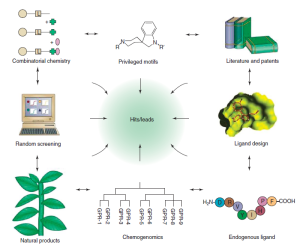Approaches to Discovery and Development of Natural Products as lead compounds
There are multiple hit identification strategies, and new drugs come from many sources, both rational and brute force. The exploitation of drug prototypes has been reviewed extensively. Some have argued that starting with an old drug is the best way to find a new drug. This has been called selective optimization of side activities (SOSA). Thus, one starts with a diverse collection of marketed drugs in order to find and then optimize hits against new pharmacological targets. Because the starting points have already proved useful in man, the hits are guaranteed to be drug-like. A number of successful SOSA examples have been reported starting from sulfonamides, calcium channel blockers, beta blockers, antidepressants, neuroleptics, and so on. Despite the power of combinatorial chemistry and HTS, natural products still provide unique structural diversity. Natural molecules have intrinsic advantages, of course, having evolved alongside biological systems. Mother Nature had eons of a head start versus medicinal chemists. Thus, it might have been predictable that a large percentage, almost 30%, of the NCEs approved by the FDA between 1981 and 2002 were natural products or compounds derived from natural products. Natural products (or derivatives) with important therapeutic uses today include the antibiotic vancomycin, the anticholinergic scopolamine, and the opiate morphine, to name just a few.
However, in recent years, natural products have gone out of favor in some circles, in part because they have been less compatible with other new technologies, such as HTS.
New drugs come from many sources including:
* Focused synthesis of new chemical structures
* Modification of old drugs (new analogs)
* New uses for old drugs (repositioning or repurposing)
* Endogenous substances found in humans;
* Natural products from non-human sources; and
* Random screening.
Though the field of combinatorial chemistry is still evolving, it has already made a mark on the industry.
Hit identification strategies.
The most commonly applied hit identification strategies today range from knowledge based approaches, which use literature- and patent-derived molecular entities, endogenous ligands or biostructural information, to the purely serendipity-based ‘brute force’ methods such as combinatorial chemistry and high-throughput screening.
Serendipity, Combinatorial chemistry and HTS play a major role in identification of lead molecules from natural products
In brief Drugs from Natural Sources can be identified by the following processes
- Serendipity
- random collection and screening of material
- Exploitation of ethnopharmacological knowledge.
- HTS – High Thoroughput Screening
- Combinatorial chemistry.


